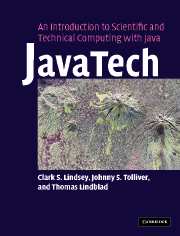Book contents
- Frontmatter
- Contents
- Preface
- Acknowledgements
- Part I Introduction to Java
- Part II Java and the network
- 13 Java networking basics
- 14 A Java web server
- 15 Client/server with sockets
- 16 Distributed computing
- 17 Distributed computing – the client
- 18 Java Remote Method Invocation (RMI)
- 19 CORBA
- 20 Distributed computing – putting it all together
- 21 Introduction to web services and XML
- Part III Out of the sandbox
- Appendix 1 Language elements
- Appendix 2 Operators
- Appendix 3 Java floating-point
- Index
- References
20 - Distributed computing – putting it all together
Published online by Cambridge University Press: 08 January 2010
- Frontmatter
- Contents
- Preface
- Acknowledgements
- Part I Introduction to Java
- Part II Java and the network
- 13 Java networking basics
- 14 A Java web server
- 15 Client/server with sockets
- 16 Distributed computing
- 17 Distributed computing – the client
- 18 Java Remote Method Invocation (RMI)
- 19 CORBA
- 20 Distributed computing – putting it all together
- 21 Introduction to web services and XML
- Part III Out of the sandbox
- Appendix 1 Language elements
- Appendix 2 Operators
- Appendix 3 Java floating-point
- Index
- References
Summary
Introduction
Chapter 16 introduced distributed computing, the UML notation language, and the design of the server side of a client/server application. Chapter 17 described the client side. Before beginning an actual implementation, it was necessary to describe Java RMI in Chapter 18. Then we took a brief detour in Chapter 19 to describe CORBA as an alternative to RMI. Now that we have all the pieces, we can put them together to build a simple example of a distributed computing application in which the calculation engine is implemented completely in Java. If the calculation engine involves legacy code in a language other than Java, then we must use JNI (the Java Native Interface, which is described in Chapter 22).
The sample application
A real client/server application using the design of Chapters 16 and 17 will be more complex than the sample described here. In fact, if the application were not somewhat complex, there would be little reason to implement it in a client/server design in the first place! However, for the sake of demonstration purposes and to provide a template for the reader's own applications, we provide a simple application that illustrates the important features of the client/server design presented in Chapters 16 and 17.
Recall that the client/server system designed earlier assumed a time-dependent simulation – i.e. one with a solution that varies as a function of time. The same approach could also work with monitoring and controlling a real system such as a remote sensor.
Information
- Type
- Chapter
- Information
- Publisher: Cambridge University PressPrint publication year: 2005
